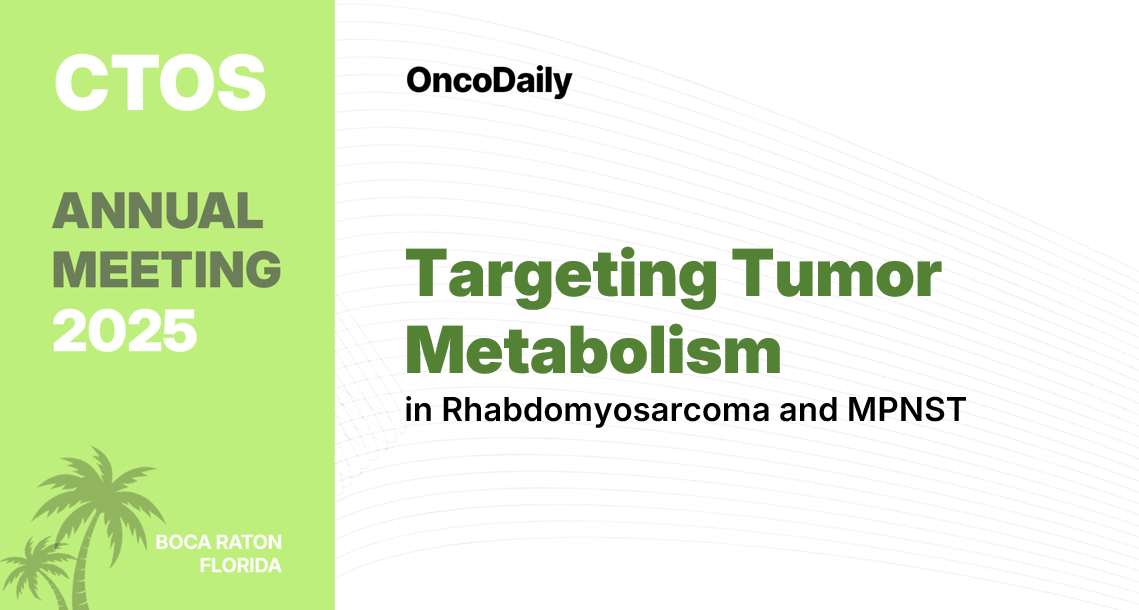At the CTOS 2025 Annual Meeting (Connective Tissue Oncology Society) Dr. Kathryn Lemberg, Assistant Professor of Oncology and Pediatrics at Johns Hopkins University, delivered one of the meeting’s most insightful sessions—exploring how cancer metabolism can be harnessed to develop new therapies for soft tissue sarcomas (STS). The focus centered on two rare and aggressive tumor types: rhabdomyosarcoma (RMS) and malignant peripheral nerve sheath tumor (MPNST).

These malignancies remain difficult to treat, with limited curative options and poor outcomes once relapse occurs. The presentation highlighted how new understanding of metabolic dependencies—from glutamine use to nucleotide synthesis—could reshape the treatment landscape for sarcoma patients.
The Metabolic Landscape of Sarcoma
Cancer metabolism has long been recognized as one of the hallmarks of malignancy, enabling tumor cells to grow rapidly, withstand therapy, and adapt to diverse environments. In soft tissue sarcomas, this metabolic flexibility becomes a critical driver of disease persistence and resistance.
Advances in mass spectrometry, NMR-based metabolite profiling, and metabolic imaging now allow researchers to capture these complex biochemical processes in unprecedented detail. Yet, despite these technological leaps, the field still faces significant challenges: limited model systems, small patient populations, and the difficulty of translating preclinical metabolic findings into effective therapies.
Rhabdomyosarcoma: Exposing Metabolic Weaknesses
Rhabdomyosarcoma (RMS), the most common soft tissue sarcoma in children, affects about 350 new patients in the U.S. each year. It arises from muscle-lineage cells and includes two main biological subtypes—PAX3/7–FOXO1 fusion–positive and fusion–negative. Standard therapy remains a combination of surgery, radiation, and VAC chemotherapy (vincristine, actinomycin D, cyclophosphamide), but outcomes for high-risk disease remain limited.
Research efforts now focus on exploiting metabolic dependencies as therapeutic entry points. Fusion-positive RMS cells, for instance, show a strong reliance on de novo pyrimidine synthesis—a pathway that fuels DNA and RNA production.
In fusion-negative RMS, glutaminase inhibition shifted the way tumors use nutrients, increasing their sensitivity to radiotherapy and leading to better tumor control in mouse models. Another key vulnerability lies in the NAD⁺ biosynthesis pathway: blocking it with NAMPT inhibitors (such as OT-82) depleted cellular energy stores and induced tumor regression in preclinical models.
These findings collectively suggest that disrupting metabolic circuits—rather than traditional signaling alone—can cripple tumor growth and enhance the effects of radiation and chemotherapy. Ongoing studies are refining how these metabolic inhibitors could be integrated into next-generation treatment protocols for pediatric sarcomas.
MPNST: Metabolism at the Core of Aggressiveness
Malignant peripheral nerve sheath tumors (MPNSTs) represent another formidable challenge in oncology. They are the leading cause of death in patients with neurofibromatosis type 1 (NF1) under the age of 40 and carry a five-year event-free survival below 30% for unresectable cases.
The disease often arises through NF1 loss, which drives RAS–ERK pathway activation, alongside frequent alterations in CDKN2A, TP53, and the PRC2 complex. Surgery remains the only curative approach, but many tumors are not amenable to resection, and both chemotherapy and radiotherapy have limited impact.
Recent research has turned attention to tumor metabolism as both a marker and a target. In MPNST, specific genetic contexts—such as CDKN2A or MTAP deletion—create distinct metabolic vulnerabilities. Preclinical work revealed that glutamine amidotransferase inhibitors (GAi) impair tumor growth by disrupting nitrogen metabolism and reducing the synthesis of nucleotides by roughly 25%.
An even more striking result emerged when GAi was combined with Pro-905, a purine salvage pathway inhibitor. Together, these agents completely halted MPNST xenograft growth, demonstrating that blocking both glutamine utilization and nucleotide recycling can produce potent synthetic lethality.
Further exploration into signaling cross-talk showed that resistance to MEK inhibition—driven by elevated HGF/MET signaling—may actually sensitize MPNST cells to glutamine-targeted therapy. These findings point to a powerful intersection between metabolic reprogramming and oncogenic signaling, suggesting new paths for combined targeting strategies.
CTOS 2025: The Road Ahead
The future of metabolic therapy in sarcoma will depend on translating these laboratory discoveries into patient-ready interventions. Research priorities now include mapping how specific tumor mutations influence metabolic sensitivity, expanding studies to other RAS-driven sarcomas, and investigating the role of glutamine-targeting drugs in shaping the immune microenvironment.
A recurring message throughout the session was that no single metabolic inhibitor will be enough. Tumors quickly adapt when one pathway is blocked. Instead, combination approaches—pairing metabolic inhibition with radiotherapy, targeted therapy, or immune modulation—represent the most realistic way forward.
Moving from Bench to Bedside
The renewed focus on cancer metabolism reflects how far the field of sarcoma biology has evolved. From advanced metabolomic profiling to genetically engineered models, researchers are now able to uncover hidden biochemical dependencies that may finally open therapeutic doors for patients with rare and devastating tumors.
Progress will depend on strong collaboration among basic scientists, clinicians, and industry partners, along with continued participation from patients and families who make this research possible.
Dr. Lemberg’s work and her collaborators at Johns Hopkins and beyond mark a significant step toward a new paradigm—one where metabolism itself becomes the Achilles’ heel of soft tissue sarcomas.
For more information clik here.
